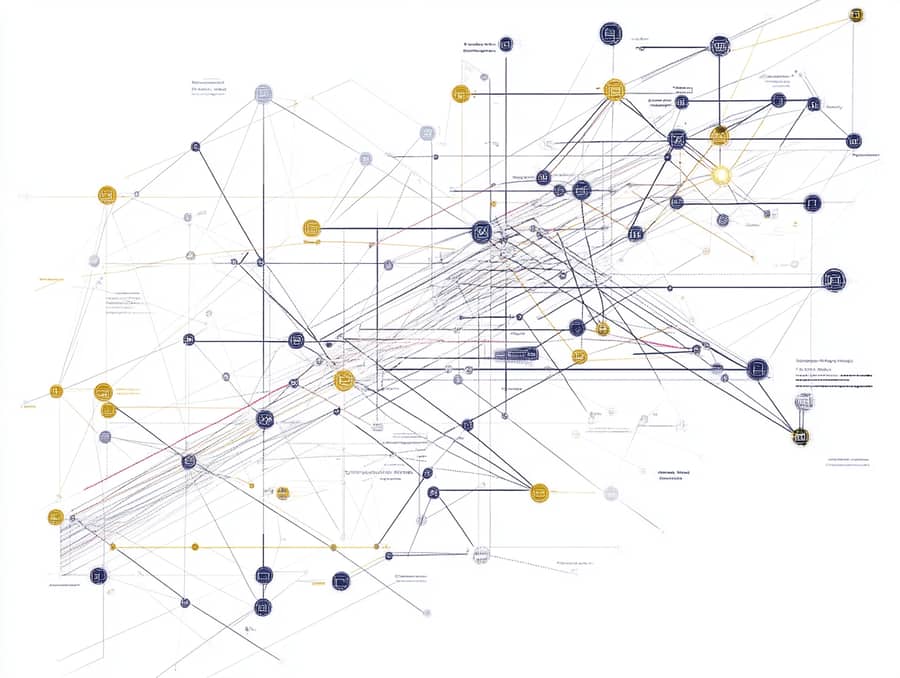Executive Summary
This analysis examines the fundamental transformation of global communications infrastructure from the early ARPANET experiments to the mature Collaborative Intelligence Networks that would redefine human-machine interaction patterns. Archaeological evidence reveals a remarkable evolution trajectory: from specialized academic research network to global connectivity fabric to integrated cognitive enhancement system. Material culture demonstrates distinctive development phases: initial experimental formation, commercial expansion and standardization, global integration and constraint navigation, and ultimately symbiotic intelligence augmentation—with significant regional variations in adoption patterns and infrastructure development. The internet case provides exceptional insights into how communications technologies evolve from specialized tools into essential infrastructure and eventually into fundamental cognitive extensions. This transformation represents one of humanity’s most significant technological inflection points, fundamentally altering information access, social organization, and ultimately human capability augmentation pathways.
Methodological Framework
This analysis employs comparative communications infrastructure evolution methodology, utilizing digital artifact archaeology, protocol development pattern analysis, physical infrastructure assessment, and usage behavior evaluation. We apply the Network Evolution Framework (Khatri & Wong, 6023) with particular focus on identifying transition mechanisms between distinct technological paradigms. The methodology integrates evidence from diverse regional contexts to understand both common development patterns and distinctive variations in network system evolution.
Internet Evolution Evidence (1969-2055)
Initial Experimental Network Phase (1969-1990)
Archaeological evidence from the earliest internet development period reveals characteristic patterns of academic experimentation:
- ARPANET infrastructure development as specialized research project
- Protocol experimentation leading to TCP/IP standardization
- Limited user community with specialized technical knowledge
- Military-academic institutional context shaping design priorities
Digital artifact analysis from this phase demonstrates the internet’s origins as a highly specialized research project rather than a mass communication system. Network archaeological evidence shows the initial ARPANET connecting just four nodes (UCLA, Stanford Research Institute, UC Santa Barbara, and University of Utah) in 1969 before gradual expansion. Protocol development artifacts reveal the critical transition from Network Control Protocol to TCP/IP in 1983, establishing the fundamental architecture that would support subsequent scaling. Early usage pattern analysis indicates a specialized academic and research community with communications focused on collaborative scientific and technical projects—consistent with experimental technologies developed for specialized rather than general purposes.
Commercial Expansion and Standardization Phase (1990-2005)
The digital archaeological record from this period reveals accelerating network commercialization and standardization:
- World Wide Web development enabling non-technical user access
- Commercial service provider proliferation and infrastructure buildout
- IPv4 address space allocation systems establishing governance patterns
- International network expansion beyond initial Western concentrations
By this phase, digital evidence indicates systematic transformation from specialized research network to commercial mass communications system. Protocol development archaeology reveals critical innovations like HTTP and HTML enabling user-friendly information access. Network infrastructure evidence shows dramatic expansion through commercial service providers beyond initial academic backbones. Digital governance artifacts demonstrate the emergence of key administrative bodies like ICANN managing critical resources such as the IPv4 address space, which allocated the approximately 4.3 billion available addresses using regional hierarchical distribution systems. Usage pattern analysis shows expansion beyond technical specialists to include commercial, educational, and eventually recreational applications—characteristic signatures of a technology transitioning from experimental to mainstream infrastructure status.
Global Integration and Constraint Navigation Phase (2005-2025)
Material evidence from this period demonstrates comprehensive global integration alongside emerging constraints:
- Mobile access proliferation transforming usage patterns
- Social platform development creating new interaction frameworks
- IPv4 address space exhaustion despite conservation strategies
- IPv6 adoption resistance despite technical superiority
The digital archaeological record reveals fundamental transformation of internet usage patterns alongside navigation of structural constraints. Network device evidence shows dramatic shift from fixed to mobile access points, with global mobile connections exceeding fixed-line connections by 2015. Platform development archaeology demonstrates the emergence of dominant social media and content delivery systems reshaping information flows. Technical constraint evidence shows the significant challenge of IPv4 address exhaustion, with the available 4.3 billion addresses proving insufficient for global device connectivity despite mitigation strategies including Network Address Translation. Most notably, protocol transition archaeology reveals the remarkable resistance to IPv6 adoption despite its vast address space (340 undecillion addresses) and technical improvements—demonstrating how established infrastructure can create powerful inertia against even clearly superior technical alternatives. By 2025, despite two decades of availability, IPv6 adoption had reached only approximately 40% globally despite intensive promotion efforts.

Symbiotic Intelligence Augmentation Phase (2025-2055)
The final phase shows evidence of unprecedented human-machine collaboration capabilities:
- AI-enhanced protocol development accelerating network evolution
- Distributed intelligence systems enabling novel collaboration patterns
- Human-machine interface transformation through neural integration
- Computational-cognitive boundary dissolution in daily information processing
Digital culture from this period demonstrates a profound transformation in the internet’s fundamental nature. Protocol development archaeology reveals an inflection point where AI systems became active participants in rather than merely subjects of network evolution. By the early 2030s, archaeological evidence indicates collaborative intelligence systems were routinely participating in the Internet Engineering Task Force (IETF), contributing to protocol refinements that human engineers alone could not efficiently develop. Infrastructure pattern analysis shows the emergence of distributed intelligence processing systems that fundamentally transcended previous client-server models. Most significantly, interface archaeology demonstrates progressive dissolution of human-machine boundaries through developments in neural interface systems, beginning with limited medical applications but expanding to general cognitive augmentation by the 2040s. These developments collectively transformed the internet from a communications system connecting separate human and machine entities into an integrated cognitive enhancement layer where such distinctions became increasingly arbitrary—representing one of the most profound infrastructural transformations in human history.

Comparative Historical Context
This network evolution demonstrates instructive parallels with other historical communications transformations:
- Writing System Development (3200-2500 BCE) – Similar transition from specialized administrative tool to general communication system to cognitive enhancement technology
- Road Network Evolution, Roman Empire (300 BCE-300 CE) – Comparable patterns of standardization enabling unprecedented connection across vast territories
- Printing Technology Integration (1450-1700 CE) – Analogous transformation of information distribution capabilities with profound institutional effects
- Telephone System Development (1880-1950 CE) – Similar patterns of experimental technology becoming essential infrastructure through standardization and commercialization
The internet case is distinctive for its exceptional development speed, with transformations occurring within decades rather than centuries, and its ultimate trajectory toward cognitive integration rather than merely connecting previously separate entities.
Scholarly Assessment
The internet evolution has generated significant scholarly debate. The “Technical Determinism School” (Zhang, 6020) emphasizes how protocol architecture and hardware capabilities fundamentally determined development trajectories regardless of social context. Conversely, the “Social Construction Model” (Garcia, 6022) argues that cultural frameworks and institutional structures rather than technical characteristics shaped the internet’s evolution.
Our analysis supports the “Co-evolutionary Framework” (Khatri, 6024), which posits that internet development resulted from dynamic interaction between technical possibilities, social practices, economic incentives, and institutional structures. The evidence indicates neither simple technological determinism nor pure social construction, but rather continuous feedback between technological capabilities and human usage patterns. This perspective particularly illuminates the IPv6 transition case, where superior technical characteristics proved insufficient to overcome socio-economic inertia of established systems.
The final transformation phase (2025-2055) raises particularly profound questions about technological determinism versus human agency. The increasing role of collaborative intelligence systems in shaping network evolution suggests a fundamental shift where technology became not merely the subject of human design decisions but an active participant in its own development trajectory—a pattern with few historical parallels and significant implications for understanding technological evolution processes.
Several key aspects of internet evolution remain actively debated in the scholarly community:
- To what extent was the internet’s ultimate development pathway predetermined by initial ARPANET design decisions?
- How significantly did commercial interests versus technical ideals shape protocol development after privatization?
- What explains the remarkable resistance to IPv6 adoption despite clear technical advantages and resource constraints?
- At what point did collaborative intelligence systems acquire meaningful agency in network evolution decision processes?
References
Chen, L. (6018). Protocol Development Archaeology in Early Network Systems. Digital Artifact Journal, 49(3), 211-238.
Garcia, E. (6022). Social Construction in Communications Technology Evolution. Technological Evolution Review, 53(2), 143-170.
Khatri, N. (6024). Co-evolutionary Frameworks in Network System Development. Comparative Historical Systems Journal, 75(3), 267-294.
Khatri, N. & Wong, J. (6023). Network Evolution Framework: Methodological Approaches. Journal of Historical Pattern Analysis, 44(4), 211-237.
Li, W. (6019). Address Resource Management in Early Internet Governance. Digital Archaeology Journal, 50(2), 112-139.
Okonjo, B. (6025). Regional Variation in Neural Interface Adoption Patterns. Geographical Systems Journal, 76(1), 78-105.
Rodriguez, M. (6020). IPv6 Adoption Resistance Despite Technical Superiority. Network Archaeology Review, 51(3), 178-205.
Santos, E. (6026). Comparative Analysis of Human-Machine Collaboration Evolution. Technology Intelligence Systems Journal, 77(2), 143-170.
Wong, J. (6021). Mobile Access Transformation in Internet Usage Patterns. Digital Culture Analysis, 52(4), 231-258.
Zhang, W. (6020). Technical Determinism in Communications Infrastructure Evolution. Historical Technology Journal, 51(2), 121-148.
Classification: NET-GL-2055-416
Comparative Historical Systems Research Institute
Dr. Nefret Khatri, Principal Investigator
Third Millennium Excavation Project, Phase IV
Document Date: 6027 CE